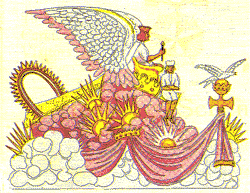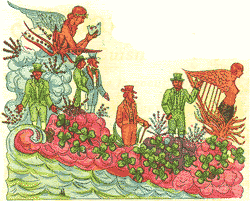![[ICC Carnival New Orleans]](g/mgtitle.gif)
![[History]](g/history.gif)
Carnival Ball Protocol
There are three distinct classes of invitations to the carnival balls. The first two are for men and women guests. Each card issued is a personal invitation to a lady or gentleman bearing their names and is not transferable. These invitations permit the invited guests to witness the staging of the tableau. Both lady and gentleman must be in evening clothes to gain admittance to the ball. Tuxedoes are permissible for gentlemen but no lady is allowed to enter tha ball if she is wearing a hat. Gentlemen receiving the regular invitations are known as "black coats" and are not allowed to participate in any of the dances until the krewe has left the floor which is usually after the 15th or 16th dance and near the midnight hour. Hermes, in this respect, has only eight maskers' dances which gives the gentleman guest or "black coat" an opportunity to dance at an earlier hour. Ladies receiving the regular invitations are accorded the same privileges as the gentlemen which is essentially that of an "audience".
 The third type of invitation is extended to ladies who are requested to
participate in the maskers' dances. These invitations are known as
"call-outs" and the holders of "call-outs" are in effect the honored
guests of the ball. Ladies with "call-outs" are accorded seats of honor
on the floor of the ballroom. No men other than members of the floor and
reception committees who must be in full costume de riguer and who are
identified by red and white carnations, are allowed on the ballroom floor
during the maskers' dances.
The third type of invitation is extended to ladies who are requested to
participate in the maskers' dances. These invitations are known as
"call-outs" and the holders of "call-outs" are in effect the honored
guests of the ball. Ladies with "call-outs" are accorded seats of honor
on the floor of the ballroom. No men other than members of the floor and
reception committees who must be in full costume de riguer and who are
identified by red and white carnations, are allowed on the ballroom floor
during the maskers' dances.
Ladies with "call-outs" remain seated until a masker "calls" for them to dance. The method of "call-outs" may be confusing to the uninitiated but is quite simple when explained or seen in operation. Following the tableau members of the floor committee seek a masker desiring to "call-out" a lady and ask the lady's name. The masker is identified by a number on his program. The committeeman shouts the name of the Lady in the "call-out" section. When she is located, he offers her his arm and leads her to the dance floor where she is presented to the masker who does not identify himself. She is presented with the krewe favor by the masker and following the dance returns to her seat to await another "call-out" while the masker requests a committeeman to obtain another "call-out" for the next dance. This procedure is followed intil the last of the maskers' dances when the entire krewe leaves the floor and turns the dancing over to any guest present at the ball.
The same rules predominate in the women's organization with the exeption that the women are masked and the gentlemen are "called-out".
In keeping with the policy of all krewes, the queen of a women's organization is not officially announced while, on the other hand, the identity of the king is formally made public when he is selected.
 Following the balls, many of the krewes have all-night supper dances at
downtown hotels or restaraunts. Practically all of the balls are staged
at Municipal Auditorium. In other years they were staged at the St.
Charles Hotel, La Salle d'Orleans, the old French Operal House, the
Athenaeum, the Orpheum and Tulane Theaters. The street pageants are
housed and built in huge buildings called "dens".
Following the balls, many of the krewes have all-night supper dances at
downtown hotels or restaraunts. Practically all of the balls are staged
at Municipal Auditorium. In other years they were staged at the St.
Charles Hotel, La Salle d'Orleans, the old French Operal House, the
Athenaeum, the Orpheum and Tulane Theaters. The street pageants are
housed and built in huge buildings called "dens".
Membership in a krewe is not limited to one organization. An individual may join as many as he is invited to become a member of.
To give you an idea of the growth of Mardi Gras, the men's krewes during the 1937 Carnival season in the order of their appearance were Harlequins, Olympian, Twelfth Night Revelers, Caliphs of Cairo, Bards of Bohemia, Nereus, Eros, Osiris, Athenians, Mithras, Prophets of Persia, Oberon, Atlanteans, Mystery, Momus, Hermes, Apollow, Melson, Mystic Club, Proteus, Rex and Comus.
Besides this group there were the krewes of Pan, Hypathians, Aparomest, Iridis, Noblad and Les Marionettes for women. Addes also are a number of smaller groups. In 1996, at least half of the krewes on this list no longer exist, but have been replaced with many more new organizations.
As the adults have their parades and pageants, so do the children of New Orleans sponsor and present their own Carnival parades and pageants. All schools in the city have their own individual Carnival programs and events. They all lead to the ultimate--participation in the big Carnival spectacles which are to come in maturity.



Copyright © 1996-2014, InterCommerce Corporation,
All Rights Reserved Worldwide
Comments & Feedback appreciated!
(http://www.icorp.net/icorp/feedback.htm)


Copyright © 1996-2014, InterCommerce Corporation, All Rights Reserved Worldwide
Comments & Feedback appreciated! (http://www.icorp.net/icorp/feedback.htm)